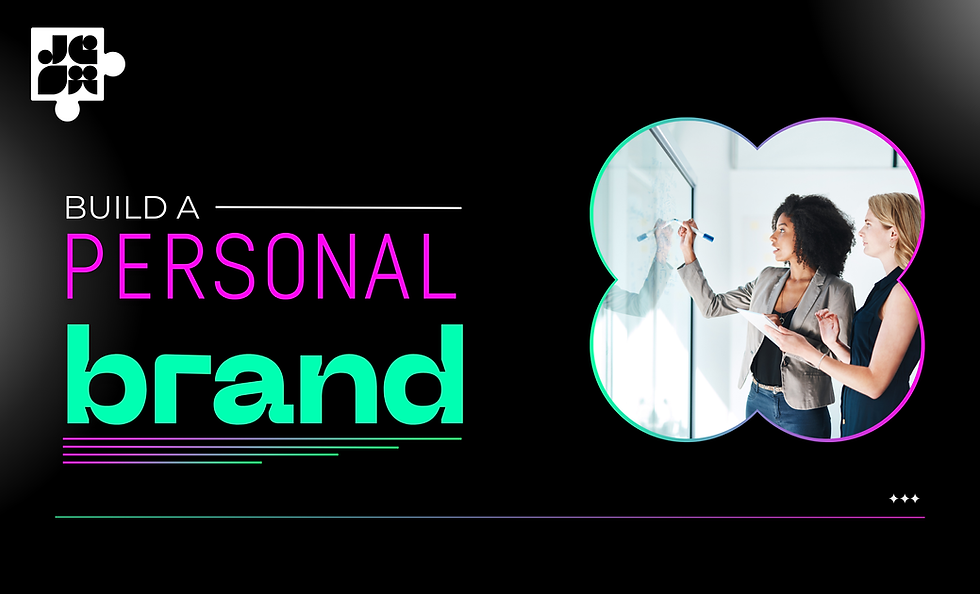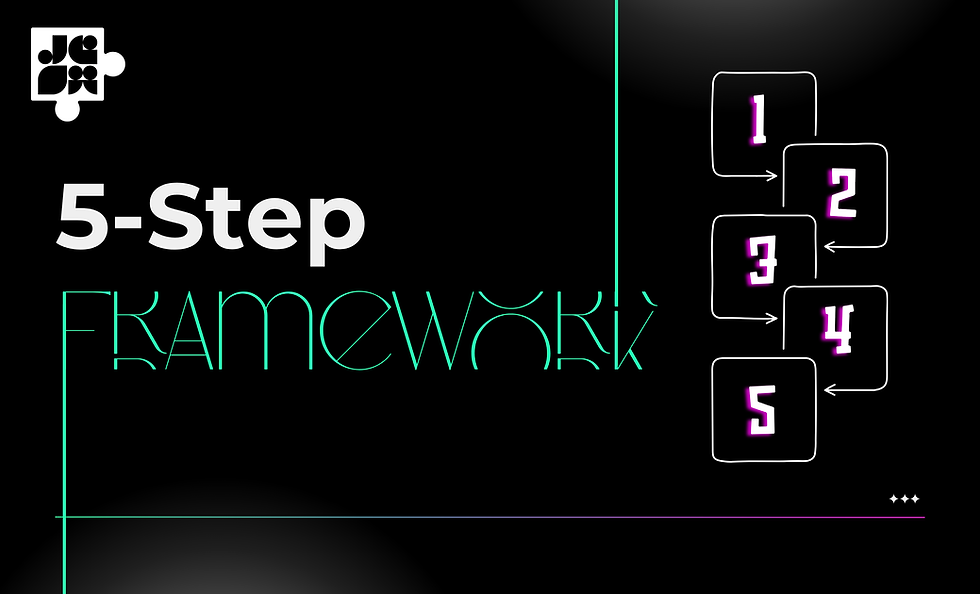Creating an Authentic Personal Brand: Building Client-Attracting Presence Online and Offline
- Jigsaw Thinking

- Sep 19
- 7 min read

If you’re a creative entrepreneur, consultant, or solopreneur, chances are you’ve already heard the phrase:
“You need to build your personal brand.”
But here’s the problem: most people think personal branding means endless self-promotion, posting selfies with #grind captions, or forcing yourself into being an influencer.
That’s not branding — that’s noise.
A real personal brand doesn't feel salesy. It feels magnetic. It's the LinkedIn article that solves a problem your ideal client faces, the Instagram story that showcases your process, the website that clearly communicates your value, and the conference conversation that leaves people remembering you weeks later. Whether online or offline, it quietly builds trust, attracts the right clients, and positions you as the go-to person in your space—creating a seamless experience that turns strangers into followers and followers into clients. So how do you actually build a personal brand that attracts clients (without feeling like you’re bragging all the time)? Let’s break it down.
Why Personal Branding Matters for Creatives (and Attracting Clients)
For creatives — designers, writers, consultants, coaches, educators, or anyone building solo businesses — your personal brand is your biggest asset.
Here’s why:
Clients buy trust, not just talent. People want to work with someone they resonate with, not just someone with skills.
The market is crowded. Thousands of others may do what you do — your brand is what differentiates you.
Consistency creates demand. When you show up with clarity, clients remember you when they need you.
In a noisy online world, your personal brand acts as a filter — it draws in aligned clients and repels the wrong ones.
The Biggest Mistake: Selling Too Hard
Many founders make the mistake of treating personal branding like a sales pitch in disguise:
Every post ends with “DM me to work together!”
Every conversation circles back to closing a deal.
Every LinkedIn update feels like an ad.
The result? People tune out.
The truth is: clients don’t want to be sold to — they want to be helped.
The best personal brands focus on sharing value, building credibility, and showing personality. Sales happen naturally as a byproduct.
The 5-Step Framework to Build a Magnetic Personal Brand

1. Get Clear on Your Positioning
Before posting anything online, ask yourself:
Who do I want to attract?
What problem do I help them solve?
Why me (not just another designer/coach/marketer)?
💡Example: Instead of saying “I’m a social media manager,” position yourself as:“I help sustainable fashion brands grow without relying on constant paid ads.”
That clarity instantly tells potential clients whether you’re the right fit.
2. Show Your Work, Not Just Your Results
Clients don’t just want to see the polished “after.” They want to understand your process, thinking, and values.
Ways to do this:
Share behind-the-scenes posts about how you work.
Break down case studies into before/after transformations.
Document your day-to-day journey (what you’re learning, experimenting with, struggling through).
💡 Example: A brand designer could share:
A moodboard for a client project.
Why they chose certain fonts/colors.
A reflection on how the client’s audience responded.
This builds credibility without ever needing to “sell.”
3. Lead With Value (Educate, Don’t Pitch)
One of the best ways to attract clients is to share helpful content consistently.
Ask yourself: what questions do my ideal clients keep asking? Create posts, videos, or blogs that answer them.
Examples:
A copywriter sharing tips on writing high-converting landing pages.
A career coach posting frameworks for negotiating salaries.
A wellness consultant explaining how to manage burnout.
When people see you as someone who helps freely, they’ll naturally think of you when they’re ready to pay.
“Not sure where to start with your own content? Our 30-second Founder Freedom Quiz gives you clarity on what type of value will attract the right clients.”
4. Build an Online Presence That Matches Your Brand
It’s not about being everywhere. It’s about being consistent in the right places.
LinkedIn → Best for B2B consultants, coaches, marketers.
Instagram → Great for visual creatives, educators, lifestyle brands.
YouTube/Podcasts → Long-form authority building.
Personal website → Your digital home (must-have).
Checklist for your online presence:
Clear bio that says what you do + who you help.
Professional photo (doesn’t need to be fancy — just authentic).
Links to your portfolio, toolkit, or booking page.
Regular content (once a week is better than 10 posts then silence).
5. Make it Easy to Work With You
A lot of solopreneurs do everything right — but then make it hard for clients to reach them.
Fix this by:
Adding a clear CTA on your posts (e.g., “Here’s my free toolkit” instead of “Hire me now”).
Keeping your contact options simple (one link, not ten).
Offering a low-barrier first step (like a free discovery call, audit, or quiz).
💡 Jigsaw example: Our Founder Freedom Quiz takes 30 seconds and gives founders a personalized toolkit. It’s useful by itself, but also an easy way for potential clients to connect with us — without feeling pressured.
The Energy Shift: From “Salesy” to “Magnetic”
The difference between salesy and magnetic branding is energy.
Salesy branding feels like chasing. You’re pushing yourself into people’s feeds and inboxes.
Magnetic branding feels like attracting. You’re putting value into the world, and clients naturally come to you.
When you focus on clarity, consistency, and contribution, your brand starts to do the selling for you.
Examples of Personal Branding Done Right

1. The Educator-Entrepreneur
An illustrator shares weekly LinkedIn posts breaking down how brands can use illustration in campaigns. She never says "Hire me" — but when companies need illustration, her name comes up first.
2. The Transparent Coach
A career coach on Instagram shares his own career pivots, the challenges he faced, and the frameworks he now teaches clients. By being relatable and human, he attracts clients who trust him.
3. The Thoughtful Founder
A D2C entrepreneur documents the behind-the-scenes of building his brand — packaging choices, supplier challenges, wins, and setbacks. Customers connect with the story, not just the product.
Pitfalls to Avoid When Building Your Personal Brand
Trying to be everything to everyone. Pick a niche, speak to them clearly.
Inconsistent showing up. Better to post once a week regularly than vanish for months.
Copying others. Your brand works best when it’s authentic, not a template.
Oversharing without value. Personal doesn’t mean unfiltered. Always tie back to what your clients care about.
The Business Case for Personal Branding
Still not convinced? Let’s look at the numbers:
A LinkedIn study found that 79% of buyers are more likely to purchase from a company whose founder has a strong personal brand.
Solopreneurs with active personal brands reported earning 25% higher client rates than those without.
In India’s growing creative economy, clients often discover service providers through content first, contracts second.
Your personal brand is more than marketing — it’s your growth engine.
Where Jigsaw Comes In

At Jigsaw, we work with creative entrepreneurs and solopreneurs who want to build businesses that attract clients sustainably — without the burnout.
Through our coaching, we help founders:
Clarify their unique positioning.
Build human-centered systems (like design thinking for branding).
Create marketing that feels authentic, not salesy.
Grow from being “Chief Everything Officer” to running businesses that work for them.
And it starts with something simple: a toolkit that shows you where your bottlenecks are and how to get unstuck.
Final Thoughts
Building a personal brand isn’t about becoming famous. It’s about becoming trusted.
The right personal brand:
Positions you as the expert in your niche.
Attracts clients without constant chasing.
Gives you freedom to grow on your terms.
And the best part? You don’t need to shout, oversell, or fake it. You just need to show up consistently, share value, and make it easy for people to take the next step.
Ready to Build a Personal Brand That Attracts Clients?
Start with 30 seconds: Founder Freedom Quiz.
You’ll get a personalized toolkit that helps you:
Identify where your brand is bottlenecking.
Clarify your message.
Build systems to attract clients authentically.
Because the strongest personal brands aren’t about selling harder. They’re about serving smarter.
Frequently Asked Questions
Q1: How do creatives build a personal brand online?
Building a personal brand online as a creative requires consistent, value-driven content that showcases both your expertise and personality. Start by choosing 1-2 primary platforms where your ideal clients spend time—LinkedIn for B2B services, Instagram for visual content, or Twitter for thought leadership.
Key strategies include:
Share your process: Document your creative work from concept to completion
Provide educational content: Teach others about your craft through tips, tutorials, and insights
Tell your story: Share your journey, challenges, and lessons learned authentically
Engage meaningfully: Comment thoughtfully on others' content and build genuine relationships
Maintain consistency: Post regularly with a consistent voice and visual style
The goal isn't to constantly promote your services, but to become known as the go-to expert in your field. When people consistently see valuable content from you, they naturally think of you when they need your services.
Q2: What's the biggest mistake in personal branding?
The biggest mistake in personal branding is treating it like advertising instead of relationship building. Many professionals focus on promoting their services rather than providing value, which creates a salesy, inauthentic presence that repels potential clients.
Common mistakes include:
Over-promoting: Constantly talking about your services instead of sharing insights
Being inconsistent: Posting sporadically or with different voices across platforms
Copying others: Mimicking successful creators instead of developing your unique perspective
Neglecting engagement: Broadcasting content without responding to comments or building relationships
Focusing on follower count: Prioritizing vanity metrics over meaningful connections
The most effective personal brands feel like having a conversation with a knowledgeable friend, not receiving a sales pitch. Focus on helping, teaching, and connecting rather than selling, and the business results will follow naturally.
Q3: How can personal branding help attract clients?
Personal branding attracts clients by establishing trust, demonstrating expertise, and creating emotional connections before any sales conversation begins. When done effectively, it positions you as the obvious choice when prospects are ready to buy.
Personal branding attracts clients by:
Building credibility: Consistent valuable content proves your expertise
Creating familiarity: Regular exposure makes prospects comfortable with you
Demonstrating results: Sharing case studies and client success stories builds confidence
Attracting the right fit: Your authentic voice naturally draws aligned clients
Generating referrals: A strong personal brand makes you memorable and referable
The power lies in attraction marketing—instead of chasing clients, your brand draws them to you. Prospects arrive already convinced of your value, making sales conversations consultative rather than persuasive. This leads to better clients, higher prices, and more sustainable business growth.
A strong personal brand essentially does your sales work for you, turning your expertise into a client magnet that works 24/7.



Comments